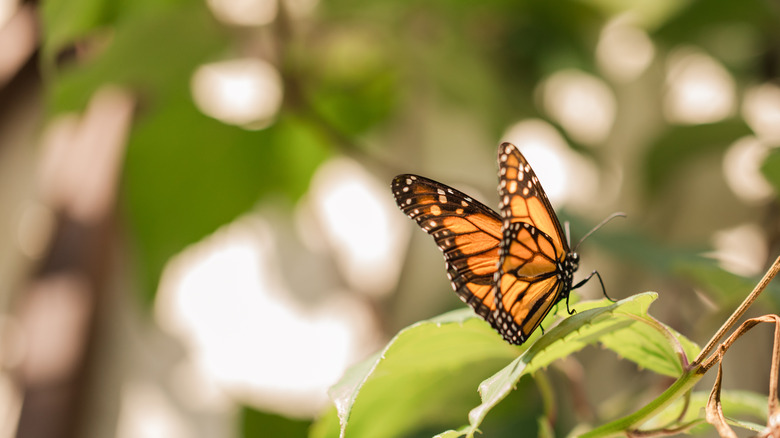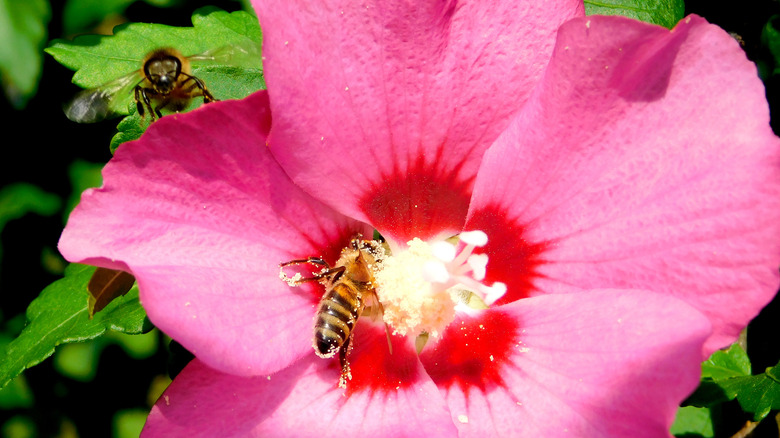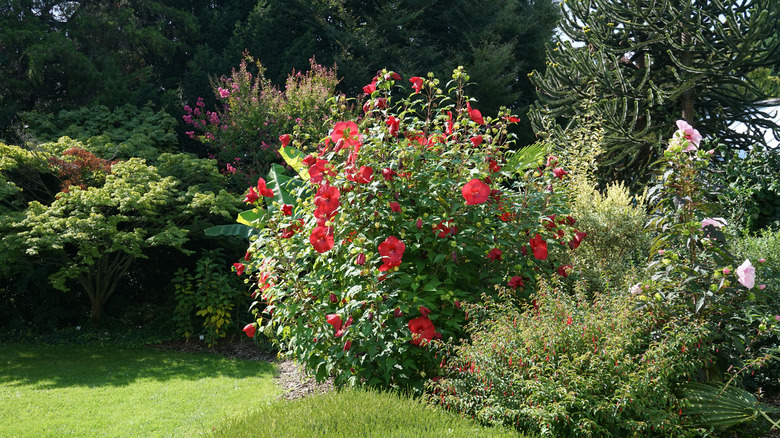The Shrubs Pollinators Especially Love For Their Massive Blooms
Creating a tropical feel in gardens that see lots of snow in the winter sounds like an impossible feat. A display of towering coconut and banana palms and enormous showy blooms is hard to achieve without a balmy equatorial climate. Unless that is, you're a U.S. gardener growing in USDA Hardiness Zones 5 to 9. Hardy hibiscus (Hibiscus moscheutos) boasts dinner plate-style and sized flowers in hot pink to crisp white to deep maroon hues and equally dramatic foliage. Unlike its heat-loving hibiscus cousins in places like Fiji and Malaysia, this herbaceous perennial easily withstands cold temperatures, going dormant in the winter only to pop back up again when the weather warms in the spring.
This easy-care plant, a native of southern and eastern North America, is an ecologist's dream. It's beloved by indigenous pollinators like hummingbirds, bees, beetles, and butterflies for its abundant pollen and nectar and provides food and nesting for caterpillars and birds. In the wild, Hibiscus moscheutos grows in marshes, swamps, wet meadows, wetlands, and along creek edges. With appropriate care and depending on the cultivar, it reaches heights of 8 feet and breadths of 4 feet. It's even considered relatively unpalatable to deer, holding a C rating (Occasionally Severely Damaged) in Rutgers' deer-resistant plants list. These traits — and rarely rivaled good looks — make it popular with U.S. nurseries and gardeners alike.
Creature comforts
Using hardy hibiscus to start a pollinator garden just makes sense. Even the dwarf varieties have palm-sized flowers, so visits from pollinators are almost a given. The blooms, which appear through the summer and well into late fall, are designed to attract them, after all. The "eye" or center of the single or double-formed flowers is typically (though not always) brighter or darker in color than the petals, highlighting the long stamen with lots of pollen-coated antlers and the tiny holes leading to extrafloral nectaries (nectar-producing growths). Some flying insects, from honeybees and bumblebees to native specialists, the rose mallow bee and hibiscus seed beetle, harvest and eat the pollen. Others, like various butterfly species, visit the flowers for their nectar. Hungry hummingbirds are big fans, too.
Hibiscus moscheutos doesn't just bring more pollinators into your yard and garden; being a native plant, it caters to the needs of a wide range of wee beasties you want to keep around. The caterpillars of many indigenous moth and butterfly species feast on the leaves and tender stems. Depending on where in the country you live, this could include the progeny of gray hairstreak, painted lady, common and tropical checkered skipper butterflies and pearly wood nymph, io, yellow scallop, and bird-dropping moths. In the spring, birds like the red-winged blackbird build nests in the foliage, and the seeds are an important winter food source — especially loved by aquatic (or semi-aquatic) birds like Northern pintails, wood ducks, and blue-winged teal.
Grow it
Finding this showy plant in your local nursery or online can be a bit confusing because it has a lot of common names — swamp and purple marsh rose mallow; swamp and rose mellow; swamp and mallow rose; sea hollyhock; wild cotton; Eastern, swamp, and crimson-eyed rose-mallow; and marshmallow, dinner plate, perennial, herbaceous, and giant hibiscus; there are tons of cultivars and hybrids, too. Buy a packet of 32 seeds of pink Hibiscus moscheutos "Palustris" for $4.95 from Sheffield's Seeds. Almost Eden sells ready-to-plant Hibiscus "Blackberry Merlot" seedlings in a 4.5-inch pot for $14.99. Logee's has "Desire" saplings, a cultivar in the popular Head Over Heels® hardy hibiscus series, in 4-inch pots for $19.95.
Hardy hibiscus is also easy to cultivate yourself from seeds or cuttings. Ask your green-thumbed neighbors or local gardening group members if they have any to share. Seedlings grown from seed don't always stay true to the variety they were harvested from, and scarification may be necessary for germination. To maximize blooms — and, therefore, cater best to pollinators — plant saplings in the ground or a large planter in full sun or part shade with a soil high in organic matter. Water consistently (drought-like conditions reduce flowering), feed with a potassium and calcium-rich fertilizer, and pinch the growing tips and deadhead flowers to encourage growth. Hardy hibiscus is slow to re-sprout in springtime, so don't get discouraged if your plant stays small for a few weeks or even months after the weather warms.


